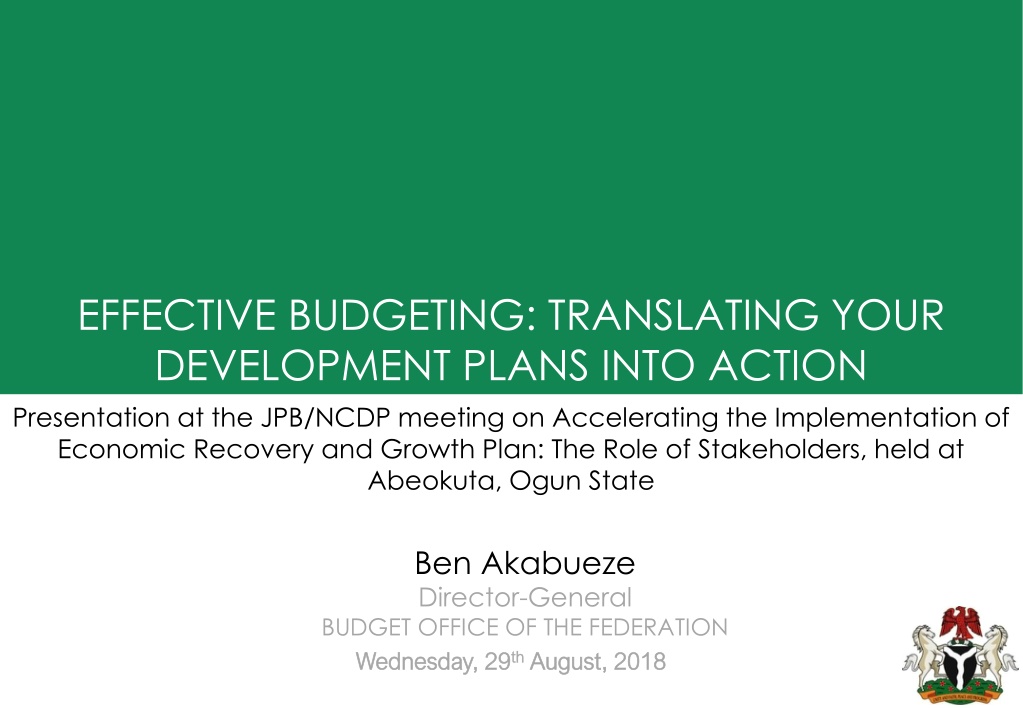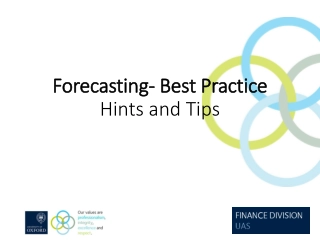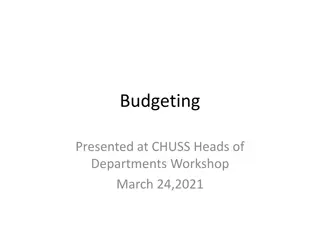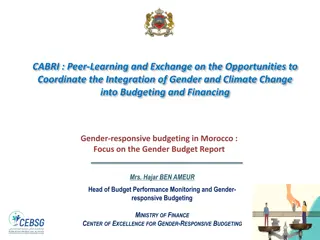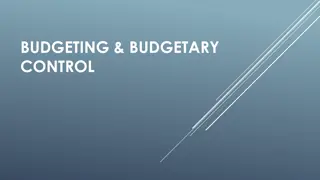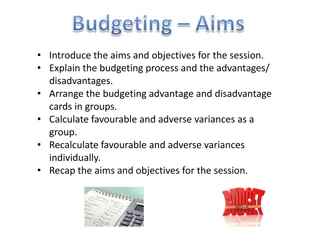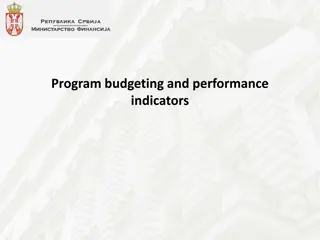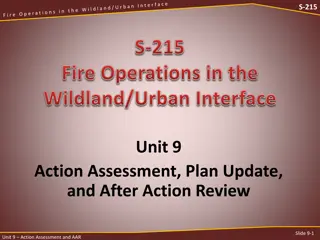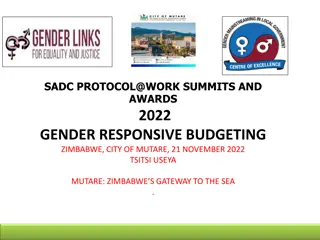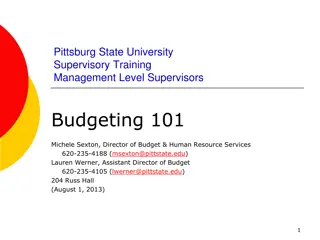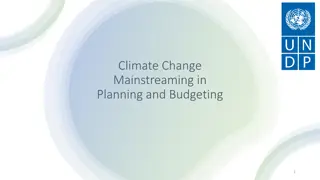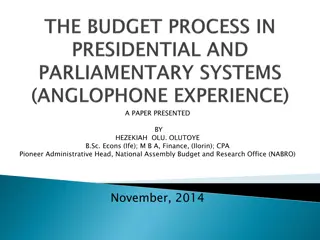Effective Budgeting: Translating Development Plans into Action
Development planning in Nigeria since the mid-1940s has aimed to foster economic growth, but success has been limited. This presentation delves into the importance of annual budgets as short-term development plans to bridge the gap between long-term goals and actionable strategies. It emphasizes the critical role of budgeting in aligning resources with key priorities for effective plan implementation.
Download Presentation

Please find below an Image/Link to download the presentation.
The content on the website is provided AS IS for your information and personal use only. It may not be sold, licensed, or shared on other websites without obtaining consent from the author. Download presentation by click this link. If you encounter any issues during the download, it is possible that the publisher has removed the file from their server.
E N D
Presentation Transcript
EFFECTIVE BUDGETING: TRANSLATING YOUR DEVELOPMENT PLANS INTO ACTION Presentation at the JPB/NCDP meeting on Accelerating the Implementation of Economic Recovery and Growth Plan: The Role of Stakeholders, held at Abeokuta, Ogun State Ben Akabueze Director-General BUDGET OFFICE OF THE FEDERATION Wednesday, 29 Wednesday, 29th th August, 2018 August, 2018 0
Outline 1.0 Introduction 2.0 Budget, a Short-Term Development Plan 3.0 The Linkage: From Plan to Budget 4.0 Some Budgeting Issues that affect Plan Implementation 5.0 Translating Development Plans into Actions 6.0 Critical Success Factors 1
INTRODUCTION Development Plan and Annual Budgets An economic development plan is a carefully built framework with a long-term in scope. It provides a comprehensive overview of the economy, sets policy direction for economic growth, and identifies strategies, programs, and projects to improve the economy. A development plan is usually based on a determined model, and made up of five components: Vision, Mission, Goals, Strategies, and Actions. It is basically about deciding in advance what to do, how to do it, when to do it and who is to do it. It is therefore a blueprint for action. Actions are the life wire of any development plan. Without actions or actionable activities, a development plan is as good as dead 2
INTRODUCTION/2 Development Plan and Annual Budgets Development planning has been a consistent phenomenon in Nigeria since the mid-1940s. However, we can argue that it has not been as successful as expected. This implies two things: either the correct plan had not always been made or correct plans made were not effectively implemented. It is important to underscore that development planning is not easy since it deals with many complex and futuristic events. This highlights the need to deliberately pursue short-term activities that are geared to the achievement of the long-term development plan. Annual Budgets are short-term development plans/activities that target at set development objectives. 3
BUDGET, A SHORT-TERM DEVELOPMENT PLAN 4
Budget, a Short-term Development Plan Budget and Budgeting Budget A budget is not just a set of revenue & expenditure plans by the Government, but culmination of government s strategic economic and fiscal policies, plans and priorities for actualising its development agenda in a fiscal year Budgeting Budgeting entails choice among competing alternatives. The purpose of budgeting is to achieve the most desirable allocation of funds among alternatives. Resource constraints vis a vis competing economic needs emphasize the need for Budgeting Even if resources were limitless there will still be need to budget because the sequencing of spending varies among MDAs and priorities must be placed on key expenditure items. 5
Budget, a Short-term Development Plan/2 Investments in economic and social infrastructure like power, transportation, roads, health and education are critical for the long- term productivity, growth and development of any Nation. However, when this Administration came into Office in 2015, revenues were down due to the collapse in oil price which began by mid- 2014. Clearly, the economy was already headed for an economic recession. As a result, the core priority of the Administration was to halt the slide and return the economy to the path of growth through an expansionary fiscal policy. 6
Budget, a Short-term Development Plan/3 To expand government s spending, there was need to raise more revenues. As a result, part of the strategic plan of government was to diversify the economy away from oil so as to make the economy non-oil driven. To achieve this, embarked on some initiatives to tackle the revenue challenge, including: Some of the initiatives being taken to address the revenue problem include: Deployment of new/improved technology to enhance revenue collection Upward review of tariffs and tax rates where appropriate Tighter performance management framework for State Owned Enterprises (SOEs), and Stronger enforcement action against tax defaulters 7
Budget, a Short-term Development Plan/4 Others include: New funding mechanism for JV operations, allowing for Cost Recovery in lieu of previous cash call arrangement. Additional oil-related revenue including: Royalty Recovery, New/Marginal Field Licences, Early licensing renewals. Review of the fiscal regime for Oil Production Sharing Contracts (PSCs) Restructuring government s equity in JV oil assets, (reduction in equity holding) with proceeds to be reinvested in other assets. Increase in Excise duty rates on alcohol and tobacco. Tax Administration improvement initiatives to positively affect collection efficiencies across various tax categories, e.g., Tax amnesty programme 8
Budget, a Short-term Development Plan/5 On the expenditure side, the FGN ensured that spending under the 2016 and 2017 budgets were focused mainly on critical ongoing infrastructure projects in sectors that could quickly revamp the economy in line with the priorities in the Strategic Implementation Plan (SIP) and subsequently the Economic Recovery and Growth Plan (ERGP), with strong focus on execution. The Execution priorities are: Macroeconomic Stability Achieving Agriculture and Food Security Ensuring Energy Sufficiency Improving Transportation Infrastructure Driving Industrialization and Small Business FGN is focused on these priorities because they have greater potentials to drive growth, job creation, security and poverty reduction which was what we needed. The 2018 Budget is designed to consolidate on the achievements of the 2016 & 2017 budgets, and advance delivery of the goals of the ERGP. 9
THE LINKAGE : FROM PLAN TO BUDGET 1 0
PLAN STRATEGY - BUDGET LINKAGE To improve budget outcomes and ensure that set objectives are met, Government designed the ERGP 2017-2020 to provide the framework that links MDAs Projects policies and strategic priorities. The link between the ERGP and the Annual Budget through the ERGP- IP/MTSS The goal is to ensure budget is policy-based consistent with medium term fiscal policy objectives Only moderate linkage observed in the past! A few examples shortly will illustrate this. development to government Economic Recovery & Growth Plan ERGP ERGP Implementation Plan / MTSS ERGP IP that the and Budget Annual Budget MTEF & FSP 11
PLAN STRATEGY - BUDGET LINKAGE/2 Plan ERGP Government Policy Thrusts & Priorities ERGP-IP / MTSS Process Strategy Sector s Results Framework Sector s Projects Objectives Programmes Outcomes Outcome Indicators Baselines Outcome Targets Projects Scoring & Prioritisation Govt s Priority Programs Selected Projects Scoring Criteria ZBB Budget 1 2
PLAN STRATEGY - BUDGET LINKAGE/3 Projects selection is central to budgetary effectiveness Key considerations projects selection include: Is the project ongoing; i.e. in 2016 or 2017 budget? Is the project aligned to govt. s priority programmes as articulated in the ERGP Implementation Plan (ERGP-IP) and the MTSS? Will the project demonstrably contribute to the achievement of ERGP objectives? Can the project be completed within the Plan period, i.e., not later than 2020? 1 3
PLAN STRATEGY - BUDGET LINKAGE/4 The linkage between the Ministry of Health s MTSS and 2017 budget was STRONG as up to 63% of total cost of MTSS projects were partially captured in the Budget while 17.1% of total cost of MTSS projects were fully captured * A review to evaluate the linkage between the ERGP-IP and the 2018 Budget will be conducted 14
PLAN STRATEGY - BUDGET LINKAGE/5 The linkage between the Ministry of Solid Minerals MTSS and 2017 budget was STRONG. Here, is a case of perfect linkage between MTSS and sector budget; an example worthy of emulation by other sectors! 15
SOME BUDGETING ISSUES THAT AFFECT PLAN IMPLEMNETATION 16
SOME BUDGETING ISSUES: THE CASE OF HEALTH SECTOR Personnel Cost Skipping of grade level despite no legal provision Huge recruitment without formal clearance from BOF Engagement of locum staff. Even casual clerical staff are often hired and embedded in the payroll. Honorary/visiting consultants who are also fully engaged as teaching staff collect multiple allowances. Resident doctors who are employees of State Governments on residency training are also catered for in the Federal Budget. 17
SOME BUDGETING ISSUES: THE CASE OF HEALTH SECTOR Capital Expenditure Many Agencies have projects that have very little or no bearing with the objectives in the ERGP. Some projects that are better executed by Agencies are included in the main Ministry s budget. Adequate provision for outsourced services not made; Undue reliance on Service Wide Votes Donor funding: Duplicate spending, Accountability, Value-for-money Transparency and accountability issues relating to internally generated revenues; Implement HealthPay application for all IGR? Aid Transition Issues Implementation of National Health Act Basic Healthcare Provision Fund 18
TRANSLATING DEVELOPMENT PLANS INTO ACTION (OUTPUT AND OUTCOMES) 19
TRANSLATING YOUR DEVELOPMENT PLANS INTO ACTION The ultimate goal of public spending is to produce outcomes and achieve state policy objectives. AGGREGATE FISCAL DISCIPLINE: means keeping government spending within sustainable limits by ensuring that government expenditures is closely aligned to what is affordable over the medium term and, in turn, within the annual budget. Setting expenditure estimates within realistic revenue forecasts, as well as the capacity to set up fiscal targets and implement them. With each ministry/commission, department, agency and interest group wrongly assuming that the budget is a free resource, and its budgetary demand is only a small proportion of the total budget there are tendencies that their demands will far exceed what it available. 20
TRANSLATING YOUR DEVELOPMENT PLANS INTO ACTION /2 The ultimate goal of public spending is to produce outcomes and achieve state policy objectives. ALLOCATIVE EFFICIENCY: refers to spending resources on the right interventions . That is, those interventions that will lead to more desirable measurable outcomes Input Activities Outcome Output Improved service delivery, New/Better assets, more capacity Budget, Physical Assets, HR capacity Improved / better health indices Interventions: Programmes & Projects Proper and timely Impact Assessment of Budgetary expenditure (Input) will strengthen the case for incremental budgetary allocations 21
TRANSLATING YOUR DEVELOPMENT PLANS INTO ACTION /3 Programme No. 1 Health Key activities Revitalize 10,000 primary health care centres and establish at least one functional primary health centre (PHC) in each ward to improve access to health care Fully implement the primary health care refinancing programme to mobilize domestic resources Drive progress to meet UN SDG health targets Reduce infant and maternal mortality rates Strategy Revitalize the primary healthcare system Roll out universal health coverage (NHIS) Expand the NHIS towards universal health care coverage Enforce the Tertiary Institutions Social Health Insurance Programme for students in tertiary institutions Pilot the Public Primary Pupils Social Health Insurance Programme to provide quality health services to pupils in middle- and lower-income socio-economic levels who are less likely to have insurance Scale up the Mobile Health Insurance Programme to provide coverage for the poor 2 22
TRANSLATING YOUR DEVELOPMENT PLANS INTO ACTION /4 Programme 3 Strengthen delivery beyond the primary health care system Health Provide anti-retroviral medication to people living with HIV/AIDS Ramp up projects to eradicate polio, measles and yellow fever Make strategic investment in tertiary health care institutions in collaboration with the National Sovereign Investment Authority and other relevant stakeholders, e.g., establish diagnostic centres in all States Develop and adopt an e-health scheme to connect specialized hospitals to rural communities via mobile tele- medicine 23
TRANSLATING YOUR DEVELOPMENT PLANS INTO ACTION /5 Programme 4 Build the capacity of health care personnel to improve service delivery Health Provide a rural service allowance and basic amenities to health workers in rural areas to retain qualified personnel Identify and fill gaps to optimize the health worker-to- population ratio by recruiting and training more health workers and attracting talent from abroad Develop the Diaspora Medical Assistance Programme to attract and encourage Nigerian medical professionals abroad to provide volunteer health services in Nigeria 24
TRANSLATING YOUR DEVELOPMENT PLANS INTO ACTION /6 TECHNICAL EFFICIENCY: refers to the capacity to implement programs and to do so at the lowest cost (minimizing inputs/costs per unit of output). The greater the output for a given cost/input the more technically efficient Greater outputs should (but not always) lead to better outcomes Technical Efficiency Analysis Key Questions Are programmes being implemented the way they were intended to be? Why not? What is the cost per unit of output? Are inputs / budgetary allocation being used efficiently? Assessments of outputs (level and quality) Trends in costs Cost per unit of output Justifying costs from a zero-base rather than benchmarking costs of an activity in a previous period Budget and Program data on inputs, costs and outputs Types of analyses Data required 25
TRANSLATING YOUR DEVELOPMENT PLANS INTO ACTION /7 EFFECTIVENESS AND BENEFIT INCIDENCE ANALYSIS focuses on the level and quality of outcomes. It measures service delivery but also equity (i.e., how benefits are distributed) A programme would be effective if it achieves the programme objectives. Effectiveness and Benefit Incidence Analysis Key Questions What are the outcomes and changes in outcomes in this sector/program area? How do they compare with policy/sectoral/program objectives? How are the outcomes and benefits distributed? To the rich or the poor? Which regions? And Why? Outcomes assessment and trends Benefit incidence analyses Programme, spending area data Household surveys which identify access to healthcare services by income groups Types of analyses Data required 26
WAY TO GO: CRITICAL SUCCESS FACTORS 27
CRITICAL SUCCESS FACTORS Gain a clear understanding of government s policies & aspirations as contained in the ERGP. Through the review of high-level policy documents (National documents, like the ERGP) Set medium-term objectives; link the objectives to policy priorities and programmes in the ERGP; break the objectives down into sector programmes; specify measurable outcomes for the respective programmes. Identify key projects that need to be executed to achieve the set objectives. Cost each project and phase them over the medium-term period bearing in mind the indicative expenditure limits of the Sector; the costing leads to sector budget. Define outputs and outcomes to be delivered to stakeholders in clear measurable terms. Agree how performance will be monitored and reported to stakeholders 28
CRITICAL SUCCESS FACTORS/2 Political support is critical for ensuring that only expenditures that would deliver on set development objectives are admitted into the budget (Hon. Commissioners must commit to it!) Support of the leadership for State Planning and Budget Team (SP&BT) is important for a successful Plan-Budget linkage, and SP&BT must be committed to task (it is a hard work!). SP&BT must exercise objectivity in projects analysis and prioritisation (to ensure meaningful project selection). Timely issuance of the expenditure limits. Stakeholders involvement and participation. 29
END Don't tell me what you value, show me your budget, and I'll tell you what you value. Joe Biden THANK YOU ! www.budgetoffice.gov.ng 30
